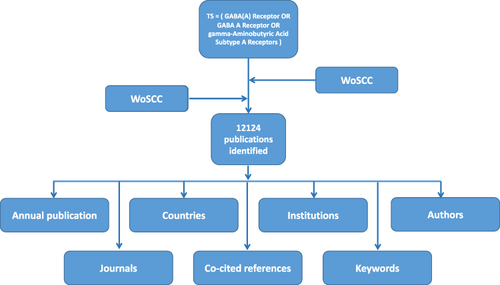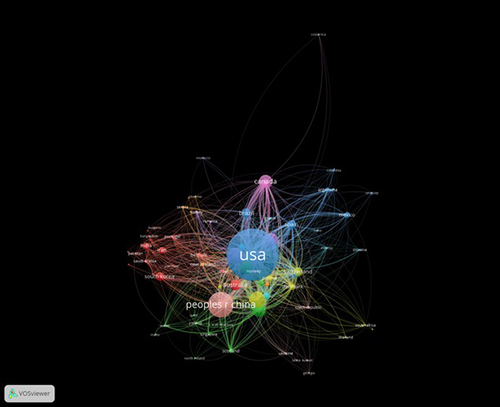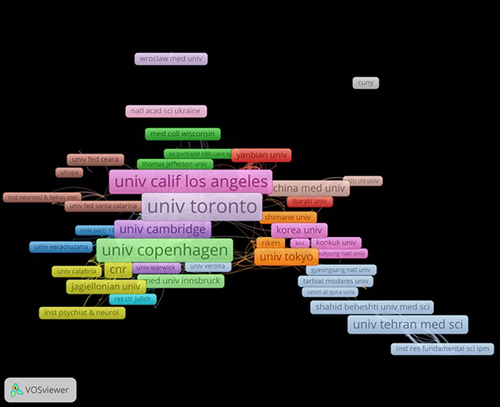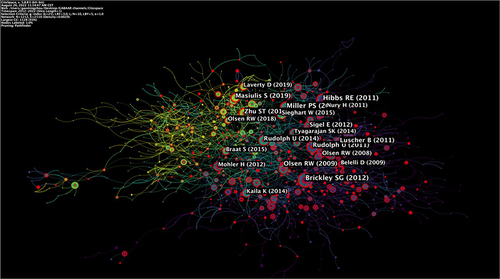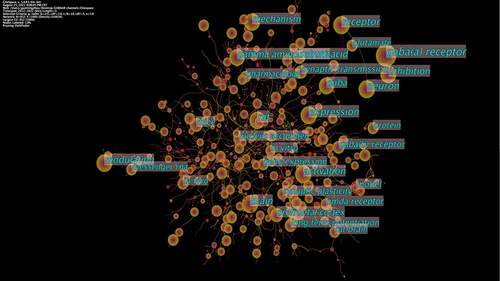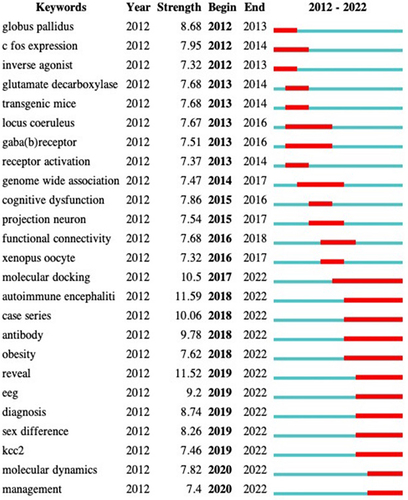Abstract
Background
GABA-A receptors are the primary mediators of brain inhibitory neurotransmission. In the past years, many studies focused on this channel to decipher the pathogenesis of related diseases but lacked bibliometric analysis research. This study aims to explore the research status and identify the research trends of GABA-A receptor channels.
Methods
Publications related to GABA-A receptor channels were retrieved from the Web of Science Core Collection from 2012 to 2022. After screening, the VOSviewer 1.6.18 and Citespace 5.8 R3 were used for bibliometric analysis from journals, countries, institutions, authors, co-cited references and keywords.
Results
We included 12,124 publications in the field of GABA-A receptor channels for analysis. The data shows that although there was a slight decrease in annual publications from 2012 to 2021, it remained at a relatively high level. Most publications were in the domain of neuroscience. Additionally, the United States was the most prolific country, followed by China. Univ Toronto was the most productive institution, and James M Cook led essential findings in this field. Furthermore, brain activation, GABAAR subunits expression, modulation mechanism in pain and anxiety behaviors and GABA and dopamine were paid attention to by researchers. And top research frontiers were molecular docking, autoimmune encephalitic series, obesity, sex difference, diagnosis and management, EEG and KCC2.
Conclusion
Taken together, academic attention on GABA-A receptor channels was never neglected since 2012. Our analysis identified key information, such as core countries, institutions and authors in this field. Molecular docking, autoimmune encephalitic series, obesity, sex difference, diagnosis and management, EEG and KCC2 will be the future research direction.
Introduction
Gamma-aminobutyric acid (GABA) is a key mediator of brain activity in mammals, acting as an inhibitory neurotransmitter.Citation1–3 There is a critical role for GABAergic neurotransmission in neurodevelopmental disorders.Citation4 Two types of receptors mediate GABA’s inhibitory effects, GABA-A receptors and GABA-B receptors.Citation5,Citation6 As ligand-gated ion channels, GABA-A receptors are heteropentamers formed from a selection of 19 subunits and one of the most significant drug targetsCitation7 in the treatment of neuropsychiatric disorders, such as depression,Citation8 aggression, anxiety,Citation9 and insomnia.Citation10 Genetic studies have documented the relationship between GABA-A receptor subunit genes and epilepsy,Citation11 eating disorder,Citation12 autism,Citation13 and bipolar disorders.Citation14 Besides, there is also interest in GABA-A receptors as potential targets for Parkinson disease and other neurological dysfunctions,Citation15 essential tremor,Citation16 ischemic stroke,Citation17 pain management.Citation18 Even some of the World’s major insecticides.Citation19–21
As research in the GABAARs continues to expand, the literature also continues to progress. Despite this, the topics and characteristics of publications on the GABA-A receptor channels have not been investigated. Bibliometric analysis has been widely used to explore research hotspots and frontiers in specific fields based on the productivity of countries, institutions, authors, and keywords.Citation22,Citation23 Using bibliometric analysis and visual analysis, we analyzed scientific publications on GABA-A receptor channels from 1999 to 2022, and we hope to provide researchers with insight into their hotspots and emerging directions.
Data Source and Search Strategy
On July 30, 2022, a data search was conducted. The data for analysis were retrieved from the Science Citation Index Expanded (SCI-expanded) of the Web of Science Core Collection (WoSCC) database from 2012 to 2022. Different from databases like Scopus, Derwent, China national knowledge infrastructure (CNKI), and the Chinese social sciences citation index (CSSCI), WoSCC includes more scientific publications and is usually regarded as the data source for bibliometric software. The search keywords entered into the database were as follows: TS =(GABA-A Receptor OR GABA A Receptor OR gamma-Aminobutyric Acid Subtype A Receptors) and language: (English).
Data Collection
Bibliographic information of every included publication was collected by downloading, screening, sorting, and extracting from WoSCC independently by two authors, including publication year, author, journal, country, institution, co-cited references and keywords. The retrieval strategy of the experiments is shown in .
Statistical Analysis
We counted the number of publications every year.Citation24 The VOSviewer 1.6.18Citation25 was used to identify top countries, institutions, authors, and journals. The Citespace 5.8 R3Citation26 analysed co-cited references and keywords for trends. Maps that visualize knowledge contain nodes and links. Each node in a map represents an institution, country, author, or keyword. Purple circles indicate nodes with high centrality, usually considered turning points or pivotal points in a field.
Results
General Information and Annual Publication Output
12,124 articles related to GABA-A receptor channels were retrieved. Based on the search results for GABA-A receptor channels in WOS, publication growth on this topic can be divided into 2 stages, a slow growth phase from 2012 to 2014 and a slow decrease phase from 2015 to 2022 (). In the past ten years, the output peaked in 2014 (1263 articles). In general, the research in this field is relatively stable and has maintained a high output in the past decade, indicating the importance of this field.
Active Journals
By analyzing journals, we can identify the core journals in this field. presents the top 10 journals by the number of publications in the field. Journal of Neuroscience (455 publications) ranks first, followed by Neuropharmacology (354 publications) and PLoS One (335 publications). Among the top 10 journals, there are 3 journals with impact factors >5, including the Journal of Neuroscience (6.709), Frontiers in Cellular Neuroscience (6.147), and Psychopharmacology (5.273). Furthermore, of the top 10 journals, 5 are from the US, 3 from England, and 2 from the Netherlands.
Table 1 Top 10 Journals That Published Publications on GABA-A Receptor Channels
Active Countries and Institutions
Scientific collaborations can be determined in this field by institutional cooperation networks and national cooperation networks using Citespace.Citation27 displays the largest cooperation network of the 112 productive countries/regions. The size of the circles represents the number of publications of countries/regions, and the shorter distance between the two circles suggests more collaboration between individual countries/regions. The purple rings outside the circle refer to centrality. As we can see, the USA (4658 publications) ranks first in the publication quantity, which is followed by PEOPLES R CHINA (1679 publications) and GERMANY (872 publications). Furthermore, shows the top 5 institutions and countries/regions that contributed to the GABA (A) Receptor channel research publications. Of them, Univ Toronto (175 publications) was the most productive country, followed by Harvard Univ (160 publications), UCL (156 publications), Univ Pittsburgh (150 publications) and Univ Wisconsin (150 publications). A network map of 1157 of 7216 institutions researching GABA (A) Receptor channels with frequency over five is shown in .
Table 2 Top Five Institutions and Countries Contributed to GABA-A Receptor Channels
Active Authors
Analysis of active authors could help us identify the core authors in this field. A total of 45,353 authors contributed 12,124 articles in this field. The network of contributing authors is demonstrated in . lists the top five most active authors. As we can see, James M Cook (94 publications), Bettler Bernhard (43 publications), Ernst Margot (43 publications), Chebib Mary (42 publications), and Rudolph Uwe (42 publications) are the top five active authors in this field. Although many authors have published relevant articles, there was little collaboration among them, suggesting that more high-quality and large-scale collaborations are needed.
Table 3 Top Five Authors That Published Articles on GABA-A Receptor Channels
Co-Cited References
To determine the key knowledge base in the field, the top five cited references about frequency are shown in , . As we can see, the first ranked citation in terms of frequency was the article in NATURE titled “Crystal structure of a human GABAA receptor”.Citation28 In this experimental work, Miller PS provided a detailed structure of a human GABAA receptor. Besides, the publication with the most incredible burst intensity (48.4) is “GABAA receptor signaling mechanisms revealed by structural pharmacology”Citation29 by Masiulis S, which reveals multiple aspects of receptor activation and provides a path for the rational design of subunit-specific GABA-A receptor modulators. In addition, most of them are reviews bringing us research progress in this field.
Table 4 Top 10 Co-Cited References in Terms of Frequency on GABA-A Receptor Channels
Keyword Co-Occurrence and Burst
Research hot topics can be described by keyword co-occurrence analysis, and burst keywords can reflect research frontiers over time.Citation30 CiteSpace was used to construct an acknowledge map of keyword co-occurrence () and identified the top 10 keywords from 1912 to 2022 () according to frequency and centrality. The top keywords were “expression” and “neuron”, with a frequency of more than 1000 times. And “dopamine neuron”, “projection”, “central amygdala”, and “chronic pain” are core keywords with a centrality of more than 0.18.
Table 5 Top 10 Keywords in Terms of Frequency and Centrality on GABA-A Receptor Channels
On the other hand, strong citation bursts were used to identify and analyze research hot topics, frontiers, and emerging trends over time (). As shown in , the red line indicates the period during which the burst keyword appears.Citation31 The citation burst time of keywords including molecular docking, autoimmune encephalitic series, antibody, obesity, reveal, EEG, diagnosis, sex difference, kcc2, molecular dynamics, and management.
Discussion
The explosive growth of research literature has brought difficulties in grasping scientific research progress. But bibliometric analysis is a widely accepted method that has emerged in recent years, providing experienced researchers with systematic and visual knowledge structures and helping new scientific researchers to get the general trends in their field.Citation30,Citation32,Citation33
Here, we conduct a bibliometric analysis of research on GABAAR channels to gain insight into its current research status and characteristics.12,124 articles on “GABA-A Receptor channels” were published in the past ten years. The current analysis of annual publication output reflects that the research heat of GABAAR channels tends to be stable, and scientific research is progressing steadily. Notably, the outputs reached a peak in 2012 and “Extra-synaptic GABAA Receptors: Their Function in the CNS and Implications for Disease”Citation34 was published in Neuron in 2012, suggesting its therapeutic target for the treatment of these diseases. Besides focusing on contributing journals, we could find that the Journal of Neuroscience is the leading journal in GABAAR research. Journal of Neuroscience publishes papers on a broad range of topics of general interest to those working on the nervous system, reflecting the close relationship between GABAAR and neuroscience.
From the perspective of scientific research cooperation, there is closer cooperation among countries, institutions and authors. Among the 112 countries and regions, the USA (4658 articles) is the leading country, followed by PEOPLES R CHINA (1679 articles). However, there is still a significant gap in research output between China and the United States, which is twice that of China. Besides, Univ Toronto is the most productive university and the core institution of GABAAR research, attracting researchers in related fields. However, the most prolific author James M Cook is from University of Wisconsin-Milwaukee. Therefore, the latest research trends can be followed by the above-mentioned high-yield national institutions and authors.
Highly cited references are classic studies that mainly address the structure and mechanisms of GABAA receptors focusing on the pharmacology revealed. For example, Miller PS’s publicationCitation28 and Brickley SG’s study.Citation34 lists the top 10 co-cited references regarding frequency on GABA A Receptor channel. As we can see, most articles are published in journals with high-impact factors, such as Nature, which shows the importance of research in this field. For instance, Miller PS’s paper titled “Crystal structure of a human GABAA receptor” presents the first three-dimensional structure of a GABAAR, revealing architectural elements unique to eukaryotic Cys-loop receptors, explains the mechanistic consequences of multiple human disease mutations and showing an unexpected structural role for a conserved N-linked glycan. Brickley SG’s paper titled “Extrasynaptic GABAA Receptors: Their Function in the CNS and Implications for Disease”Citation34 suggested that extrasynaptic GABA(A) Rs could be regarded as therapeutic targets for the treatment of CNS diseases. Hibbs RE’s paper titled “Principles of activation and permeation in an anion-selective Cys-loop receptor”Citation35 presents the first three-dimensional structure of an inhibitory anion-selective Cys-loop receptor. Masiulis S’s paper titled “GABAA receptor signalling mechanisms revealed by structural pharmacology”Citation29 provides a structural framework to integrate previous physiology and pharmacology research and a rational basis for developing GABAA receptor modulators. Rudolph U’s paper titled “Beyond classical benzodiazepines: novel therapeutic potential of GABAA receptor subtypes”Citation36 suggested that receptor subtype-selective compounds could overcome the limitations of classical benzodiazepines; furthermore, they might be valuable for novel indications, such as chronic pain, depression, schizophrenia, cognitive enhancement, and stroke.
Furthermore, keyword co-occurrence indicates current hotspots, such as brain activation, GABAAR subunits expression, modulation mechanism in pain and anxiety behaviour, and GABA and dopamine.
Brain Activation
In neuroscience, brain activation has always been a research hot topics. Abnormal activation of the central amygdala is a vital direction.Citation37–39 Furthermore, abnormal brain activation in patients with diseases where GABAAR plays an important role has been found, like premenstrual dysphoric disorder.Citation40 A deeper activation mechanism could be located at GABAAR. And distribution, density, and activity of receptors in the brain can be visualized by brain imaging technology.Citation41 Research shows that Radixin regulates synaptic GABAA receptor density to reverse learning and short-term memory.Citation42 And activation of GABAA receptors enhances behavioral recovery in the brain.Citation31
Expression and Function of GABAAR Subunits
The GABAARs are constituted from different subunits (α1–6, β1–3, γ1–3, δ, ε, θ, π, and ρ1–3), involving different functions referring to abnormal expression of GABAA receptor subunits.Citation43 For instance, the zebrafish model of gabra1 deficiency proved that GABRA1 might regulate brain development.Citation44 β3 subunit is a critical player in GABAAR performance and an essential contributor to the appearance of severe neurological disorders, such as epilepsy, autism, and other syndromes.Citation43 And an aberrant expression of GABAAR subunits α1 and β2 in the stargazers is unlikely to directly contribute to the initiation of absence seizures.Citation45,Citation46 δ-GABAARs mediate a slow constant inhibitory current called tonic inhibition during health and disease.Citation47 Therefore, at the current stage, the regulatory functions of GABAAR subunits under different expressions are becoming more and more significant in life activities and diseases.
Modulation Mechanism in Pain and Anxiety Behavior
As positive and negative allosteric modulators, GABAA receptors are abundant in the central nervous system and are prolific drug targets for treating anxiety.Citation48 GABAA-receptor dysfunction in patients as a causal predisposition to anxiety disorders. F Crestani’s finding proved that GABAA-receptor dysfunction in patients is a causal predisposition to anxiety disorders.Citation49 Notably, GABAA(δ)R plays a vital role in regulating anxiety-like behavior proved by rats.Citation50 Giorgia Quadrato’s study shows that the NFATc4-dependent increase in hippocampal neurogenesis after GABAAR stimulation is required to suppress the anxiety response in mice.Citation51,Citation52 Besides, GABAkines discovery are also ongoing to identify novel drug for the treatment of acute and chronic pain.Citation53
Keyword burst indicating future research direction, such as molecular docking, autoimmune encephalitic series, obesity, sex difference, EEG and KCC2.
Molecular Docking
Molecular docking technology is a new technology based on computer technology that assists drug molecular design.Citation54 This technology starts from the receptors and ligands with known structures to identify the interactions between molecules and predict the best binding mode between two molecules. For now, it is used to explore the potential targets and action mechanisms of effective components of traditional Chinese medicine.Citation55 Abnormal GABA receptor pathway is common in psychiatric diseases, such as abnormal GABAergic system in the brain of schizophrenics.Citation56 GABA exerts biological activity through GABA receptors (mainly GABAAR). However, previous studies have not found evidence of a direct combination of antipsychotic drugs and GABAAR, and the mechanism of antipsychotic drugs regulating GABAAR is still unclear. But there is also evidence that selective alpha1-GABA-A positive allosteric modulators exert antipsychotic activity.Citation57 Drug research on anti-anxiety targets of GABAAR is also a research hotspot.Citation58 Molecular docking technology is an important early foundation and also a research hotspot in the future.
Autoimmune Encephalitic Series
Autoimmune encephalitis (AE) belongs to neuron-related antibody encephalitis. The main neuropathological characteristics of AE are the infiltration of lymphocytic inflammatory cells into brain parenchyma and the formation of sleeve-like structures around blood vessels, one of the focuses of many neuroimmunological studies.Citation59 From the pathogenesis perspective, AE is a disease caused by the antigen–antibody reaction on the cell surface or in the cell of the central nervous system, γ Aminobutyric acid receptor (GABAR, GABAR is divided into GABA-A R and GABA-B R) is one of them.Citation60 Research shows that epileptic seizures are the most common in anti-LGI encephalitis and anti-GABAR encephalitis. Still, the latter has an acute onset, both autoimmune synaptic encephalitis. LGI1 acts with epilepsy-related proteins ADAM22 and ADAM23.Citation61 Anti-GABAR can change synaptic function, but patients with anti-GABAR encephalitis have early, frequent seizures or status epilepticus.Citation62 More in-depth research on pathogenesis and treatment is still in progress.
Obesity
Obesity can lead to a higher risk of early death and increase overall mortality. It has become a global “epidemic” associated with various chronic diseases. The research shows that the GABAergic signal in the nucleus accumbens can regulate the expression of MCH in neurons of the lateral hypothalamus. The sensitivity of MCH neurons in LHA of obese rats to satiety signal decreases, and reward feeding increases.Citation63 In addition, energy metabolism and obesity-related diseases are severe threats to human health. In addition to the direct involvement of the central nervous system in regulating the peripheral digestive system, the central nervous system can further influence feeding behaviour through the feeding “reward” pathway, thus regulating energy metabolism. Nucleus accumbens (NAc) contain GD neurons that receive afferent information from gastric mechanical traction stimulation, and the altered excitation of these neurons may be associated with changes in gastric motility. GABA-A receptor activation is an important factor in this regulation, and the Glucagon-like peptide 1 (GLP-1) receptor signaling pathway is also involved in regulating this process.Citation64 Recent studies indicated that high comorbidity between obesity and mental disorders often exacerbates metabolic and neurological symptoms significantly. Reciprocal control of obesity via a GABAAR is becoming more and more important.Citation65
Sex Difference
Gender differences exist in many life activities and disease processes.Citation66 Gender differences in depression first appear in adolescence, women are more likely to be depressed, and this trend will continue into adulthood; the incidence of men and women is about 1:2.Citation67 The study confirmed that THIP exerts rapid antidepressant effects on prepubertal and early adolescent female mice models of depression caused by chronic stress through activation of the δ-GABAAR subunit, providing a new idea for the treatment of clinical depression in teenage females.Citation68 Future studies focusing on gender differences in the pathogenesis of GABAAR are potential research directions.
EEG and KCC2
Electroencephalography (EEG) is the acquisition of microvolt-level electrical signals generated by synchronised neuronal activity within the brain by electrodes placed at specific locations on the scalp. The GABAAR pathway has significant research potential for excitability in the human brain.Citation69 In addition, the excitatory effects of GABA mainly depend on the intracellular chloride concentration of neurons, in which Na+-K+-Cl− cotransporter 1 (NKCC1) promotes intracellular Cl− accumulation, while K+-Cl− cotransporter 2 (KCC2) excludes intracellular Cl− and decreases intracellular Cl− concentration. Therefore, the association of KCC2 with GABAAR channels has also been investigated.Citation70
Limitation
To the best of our knowledge, this is the first study to illustrate trends in GABAAR research over the past decade using bibliometric analysis. We present the first comprehensive research posture of the GABAAR pathway, facilitating researchers to target their research directions and conduct more in-depth studies. Due to the limitation of Citespace software, we use WoSCC as the source of publications, and may ignore publications of other databases, such as patents. However, the WoSCC database is widely recognized in the field of bibliometrics, and its results are reliable.
Conclusions
Based on the WoSCC database, we comprehensively analysed the research status and trends of the GABAAR channels by mapping the knowledge map of authors, institutions, keywords, and so on. The United States was the most prolific country. And Univ Toronto was the most productive institution, and James M Cook led essential findings. Furthermore, the structure and signalling mechanisms of the GABAA receptor are the current knowledge structure. Research hot topics were brain activation, GABAAR subunits expression, modulation mechanism in pain and anxiety behaviors, and GABA and dopamine. And top research frontiers were molecular docking, autoimmune encephalitic series, obesity, sex difference, diagnosis and management, EEG and KCC2.
Author Contributions
All authors made a significant contribution to the work reported, whether that is in the conception, study design, execution, acquisition of data, analysis and interpretation, or in all these areas; took part in drafting, revising or critically reviewing the article; gave final approval of the version to be published; have agreed on the journal to which the article has been submitted; and agree to be accountable for all aspects of the work.
Disclosure
The authors report no conflicts of interest in this work.
Acknowledgments
We are grateful to the experimental platform and conditions provided by the Research and Innovation team of Emotional Diseases and Syndromes in Shandong University of Traditional Chinese Medicine and all team members for their help in the experiment.
Additional information
Funding
References
- Petroff OA. GAB A and glutamate in the human brain. Neuroscientist. 2002;8(6):562–573. doi:10.1177/1073858402238515
- Bak LK, Schousboe A, Waagepetersen HS. The glutamate/GABA-glutamine cycle: aspects of transport, neurotransmitter homeostasis and ammonia transfer. J Neurochem. 2006;98(3):641–653. doi:10.1111/j.1471-4159.2006.03913.x
- George K, Preuss CV, Sadiq NM. GABA Inhibitors. Treasure Island (FL): StatPearls; 2022.
- Ramamoorthi K, Lin YX. The contribution of GABAergic dysfunction to neurodevelopmental disorders. Trends Mol Med. 2011;17(8):452–462. doi:10.1016/j.molmed.2011.03.003
- Simeone TA, Donevan SD, Rho JM. Molecular biology and ontogeny of gamma-aminobutyric acid (GABA) receptors in the mammalian central nervous system. J Child Neurol. 2003;18(1):39–48. doi:10.1177/08830738030180012101
- Jembrek MJ, Vlainic J. GABA Receptors. Pharmacological Potential and Pitfalls. Curr Pharm Des. 2015;21(34):4943–4959. doi:10.2174/1381612821666150914121624
- Knoflach F, Bertrand D. Pharmacological modulation of GABAA receptors. Curr Opin Pharmacol. 2021;59:3–10. doi:10.1016/j.coph.2021.04.003
- Mody I. GABAAR Modulator for Postpartum Depression. Cell. 2019;176(1–2):1. doi:10.1016/j.cell.2018.12.016
- Miczek KA, Weerts EM, Vivian JA, Barros HM. Aggression, anxiety and vocalizations in animals: GABAA and 5-HT anxiolytics. Psychopharmacology (Berl). 1995;121(1):38–56. doi:10.1007/BF02245590
- Mohler H. GABAA receptors in central nervous system disease: anxiety, epilepsy, and insomnia. J Recept Signal Transduct Res. 2006;26(5–6):731–740. doi:10.1080/10799890600920035
- Korpi ER, Sinkkonen SI. GABA(A) receptor subtypes as targets for neuropsychiatric drug development. Pharmacol Therapeut. 2006;109(1–2):12–32.
- Bloss CS, Berrettini W, Bergen AW, et al. Genetic association of recovery from eating disorders: the role of GABA receptor SNPs. Neuropsychopharmacol. 2011;36(11):2222–2232. doi:10.1038/npp.2011.108
- Collins AL, Ma D, Whitehead PL, et al. Investigation of autism and GABA receptor subunit genes in multiple ethnic groups. Neurogenetics. 2006;7(3):167–174. doi:10.1007/s10048-006-0045-1
- Ament SA, Szelinger S, Glusman G, et al. Rare variants in neuronal excitability genes influence risk for bipolar disorder. Proc Natl Acad Sci U S A. 2015;112(11):3576–3581. doi:10.1073/pnas.1424958112
- Bomalaski MN, Claflin ES, Townsend W, Peterson MD. Zolpidem for the Treatment of Neurologic Disorders: a Systematic Review. JAMA Neurol. 2017;74(9):1130–1139. doi:10.1001/jamaneurol.2017.1133
- Kosmowska B, Paleczna M, Biała D, et al. GABA-A Alpha 2/3 but Not Alpha 1 Receptor Subunit Ligand Inhibits Harmaline and Pimozide-Induced Tremor in Rats. Biomolecules. 2023;13(2):197. doi:10.3390/biom13020197
- Liu B, Li L, Zhang Q, et al. Preservation of GABAA receptor function by PTEN inhibition protects against neuronal death in ischemic stroke. Stroke. 2010;41(5):1018–1026. doi:10.1161/STROKEAHA.110.579011
- Luo Y, Kusay AS, Jiang T, Chebib M, Balle T. Delta-containing GABA(A) receptors in pain management: promising targets for novel analgesics. Neuropharmacology. 2021;195:108675. doi:10.1016/j.neuropharm.2021.108675
- Masiulis S, Desai R, Uchański T, et al. GABA(A) receptor signalling mechanisms revealed by structural pharmacology. Nature. 2019;565(7740):454–459. doi:10.1038/s41586-018-0832-5
- Ratra GS, Casida JE. GABA receptor subunit composition relative to insecticide potency and selectivity. Toxicol Lett. 2001;122(3):215–222. doi:10.1016/S0378-4274(01)00366-6
- Bertaud A, Cens T, Mary R, et al. Xenopus Oocytes: a Tool to Decipher Molecular Specificity of Insecticides towards Mammalian and Insect GABA-A Receptors. Membranes (Basel. 2022;12(5). doi:10.3390/membranes12050440
- Chen CM, Dubin R, Kim MC. Emerging trends and new developments in regenerative medicine: a scientometric update (2000-2014). Expert Opin Biol Th. 2014;14(9):1295–1317. doi:10.1517/14712598.2014.920813
- Chen C, Song M. Visualizing a field of research: a methodology of systematic scientometric reviews. PLoS One. 2019;14(10):e0223994. doi:10.1371/journal.pone.0223994
- Wang W, Dong XX, Qu JW, Lin YY, Liu L. Bibliometric Analysis of Microtia-Related Publications From 2006 to 2020. Ent-Ear Nose Throat. 2021;014556132110376. doi:10.1177/01455613211037641
- Yu YT, Li YJ, Zhang ZH, et al. A bibliometric analysis using VOSviewer of publications on COVID-19. Ann Transl Med. 2020;8(13):816. doi:10.21037/atm-20-4235
- Synnestvedt MB, Chen C, Holmes JH. CiteSpace II: visualization and knowledge discovery in bibliographic databases. AMIA Annu Symp Proc. 2005;2005:724–728.
- Wu WW, Xie YF, Liu XX, et al. Analysis of Scientific Collaboration Networks among Authors, Institutions, and Countries Studying Adolescent Myopia Prevention and Control: a Review Article. Iranian Journal of Public Health. 2019;48(4):621–631.
- Miller PS, Aricescu AR. Crystal structure of a human GABAA receptor. Nature. 2014;512(7514):270–275. doi:10.1038/nature13293
- Masiulis S, Desai R, Uchanski T, et al. GABAA receptor signalling mechanisms revealed by structural pharmacology. Nature. 2019;565(7740):454–459.
- Ahmad P, Asif JA, Alam MK, Slots J. A bibliometric analysis of Periodontology 2000. Periodontol. 2000;82(1):286–297. doi:10.1111/prd.12328
- Wang H, Cheng X, Yu H, et al. Activation of GABAA receptors enhances the behavioral recovery but not axonal sprouting in ischemic rats. Restor Neurol Neurosci. 2019;37(4):315–331. doi:10.3233/RNN-180827
- Hassan W, Zafar M, Duarte AE, Kamdem JP, Teixeira da Rocha JB. Pharmacological Research: a bibliometric analysis from 1989 to 2019. Pharmacol Res. 2021;169:105645. doi:10.1016/j.phrs.2021.105645
- Yang Q, Yang D, Li P, Liang S, Zhang Z, Bibliometric A. Visual Analysis of Global Community Resilience Research. Int J Environ Res Public Health. 2021;18(20):6354.
- Brickley SG, Mody I. Extrasynaptic GABA(A) Receptors: their Function in the CNS and Implications for Disease. Neuron. 2012;73(1):23–34. doi:10.1016/j.neuron.2011.12.012
- Hibbs RE, Gouaux E. Principles of activation and permeation in an anion-selective Cys-loop receptor. Nature. 2011;474(7349):54–U80. doi:10.1038/nature10139
- Rudolph U, Knoflach F. Beyond classical benzodiazepines: novel therapeutic potential of GABAA receptor subtypes. Nat Rev Drug Discov. 2011;10(9):685–697. doi:10.1038/nrd3502
- Nakamura Y, Nakamura Y, Pelosi A, et al. fMRI detects bilateral brain network activation following unilateral chemogenetic activation of direct striatal projection neurons. Neuroimage. 2020;220:117079. doi:10.1016/j.neuroimage.2020.117079
- Wahis J, Baudon A, Althammer F, et al. Astrocytes mediate the effect of oxytocin in the central amygdala on neuronal activity and affective states in rodents. Nat Neurosci. 2021;24(4):529–541. doi:10.1038/s41593-021-00800-0
- Hardaway JA, Halladay LR, Mazzone CM, et al. Central Amygdala Prepronociceptin-Expressing Neurons Mediate Palatable Food Consumption and Reward. Neuron. 2019;102(5):1088. doi:10.1016/j.neuron.2019.04.036
- Gao M, Qiao M, An L, et al. Brain reactivity to emotional stimuli in women with premenstrual dysphoric disorder and related personality characteristics. Aging (Albany NY). 2021;13(15):19529–19541. doi:10.18632/aging.203363
- Herfert K, Mannheim JG, Kuebler L, et al. Quantitative Rodent Brain Receptor Imaging. Mol Imaging Biol. 2020;22(2):223–244. doi:10.1007/s11307-019-01368-9
- Hausrat TJ, Muhia M, Gerrow K, et al. Radixin regulates synaptic GABAA receptor density and is essential for reversal learning and short-term memory. Nat Commun. 2015;6:6872. doi:10.1038/ncomms7872
- Olsen RW. GABAA receptor: positive and negative allosteric modulators. Neuropharmacology. 2018;136(Pt A):10–22. doi:10.1016/j.neuropharm.2018.01.036
- Reyes-Nava NG, Yu HC, Coughlin CR, Shaikh TH, Quintana AM. Abnormal expression of GABAA receptor subunits and hypomotility upon loss of gabra1 in zebrafish. Biol Open. 2020;9(4). doi:10.1242/bio.051367
- Menzikov SA, Morozov SG, Kubatiev AA. Intricacies of GABAA Receptor Function: the Critical Role of the beta3 Subunit in Norm and Pathology. Int J Mol Sci. 2021;22(3):1457. doi:10.3390/ijms22031457
- Seo S, Leitch B. Postnatal expression of thalamic GABAA receptor subunits in the stargazer mouse model of absence epilepsy. Neuroreport. 2017;28(18):1255–1260. doi:10.1097/WNR.0000000000000909
- Arslan A. Extrasynaptic delta-subunit containing GABAA receptors. J Integr Neurosci. 2021;20(1):173–184. doi:10.31083/j.jin.2021.01.284
- Mohler H. The GABA system in anxiety and depression and its therapeutic potential. Neuropharmacology. 2012;62(1):42–53. doi:10.1016/j.neuropharm.2011.08.040
- Crestani F, Lorez M, Baer K, et al. Decreased GABAA-receptor clustering results in enhanced anxiety and a bias for threat cues. Nat Neurosci. 1999;2(9):833–839. doi:10.1038/12207
- He Y, Zheng ZH, Zhou J, et al. Gender-dependent regulation of anxiety-like behavior by delta subunit-containing GABAA receptor during postnatal development. Neuroreport. 2019;30(11):753–759. doi:10.1097/WNR.0000000000001192
- Jiao XY, Jin X, Ma YY, et al. A comprehensive application: molecular docking and network pharmacology for the prediction of bioactive constituents and elucidation of mechanisms of action in component-based Chinese medicine. Comput Biol Chem 2021;1:90.
- Chen WJ, Lin TY, He Q, et al. Study on the potential active components and molecular mechanism of Xiao Huoluo Pills in the treatment of cartilage degeneration of knee osteoarthritis based on bioinformatics analysis and molecular docking technology. J Orthop Surg Res. 2021;16(1):563.
- Cerne R, Lippa A, Poe MM, et al. GABAkines – advances in the discovery, development, and commercialization of positive allosteric modulators of GABA(A) receptors. Pharmacol Ther. 2022;234:108035. doi:10.1016/j.pharmthera.2021.108035
- Saikia S, Bordoloi M. Molecular Docking: challenges, Advances and its Use in Drug Discovery Perspective. Current Drug Targets. 2019;20(5):501–521. doi:10.2174/1389450119666181022153016
- Vinkers CH, Mirza NR, Olivier B, Kahn RS. The inhibitory GABA system as a therapeutic target for cognitive symptoms in schizophrenia: investigational agents in the pipeline. Expert Opin Inv Drug. 2010;19(10):1217–1233. doi:10.1517/13543784.2010.513382
- Chang CY, Chen YW, Wang TW, et al. Akting up in the GABA hypothesis of schizophrenia: Akt1 deficiency modulates GABAergic functions and hippocampus-dependent functions[J]. Scientific Reports. 2016;6: 33095. doi:10.1038/srep33095
- Zheng X, Wang C, Zhai N, Luo X, Liu G, Ju X. In Silico Screening of Novel α1-GABA(A) Receptor PAMs towards Schizophrenia Based on Combined Modeling Studies of Imidazo [1,2-a]-Pyridines. Int J Mol Sci. 2021;22(17):9645. doi:10.3390/ijms22179645
- Poisbeau P, Gazzo G, Calvel L. Anxiolytics targeting GABAA receptors: insights on etifoxine. World J Biol Psychiatry. 2018;19(sup1):S36–S45. doi:10.1080/15622975.2018.1468030
- Kelley BP, Patel SC, Marin HL, Corrigan JJ, Mitsias PD, Griffith B. Autoimmune Encephalitis: pathophysiology and Imaging Review of an Overlooked Diagnosis. AJNR Am J Neuroradiol. 2017;38(6):1070–1078. doi:10.3174/ajnr.A5086
- Graus F, Saiz A, Dalmau J. Antibodies and neuronal autoimmune disorders of the CNS. Journal of Neurology. 2010;257(4):509–517. doi:10.1007/s00415-009-5431-9
- Lai MZ, Huijbers MGM, Lancaster E, et al. Investigation of LGI1 as the antigen in limbic encephalitis previously attributed to potassium channels: a case series. Lancet Neurol. 2010;9(8):776–785. doi:10.1016/S1474-4422(10)70137-X
- Hoftberger R, Sabater L, Kruer M, et al. Encephalitis and GABAB receptor antibodies: novel findings in a new case series of 20 patients. Journal of Neurology. 2013;260:S21–S21.
- Jieting K. He Xiaoman, Ji Pengfei, Li Junshu, Ma Xinqi, Shang Gaohao, Guo Feifei, Zhang Nana. Regulatory Effects of GABA and MCH Neurons in the Nucleus Accumbens Hypothalamus Lateral Area on Reward Feeding in Obese Rats Chinese Journal of Behavioral Medicine and Brain Science. 2022;31(05):400–406.
- Qian W. Study on the effects and potential mechanisms of the GABA neural pathway in the nucleus accumbens of the undecided zone on gastric function and food intake in rats Master’s degree Qingdao University. 2020.
- Xia G, Han Y, Meng F, et al. Reciprocal control of obesity and anxiety-depressive disorder via a GABA and serotonin neural circuit. Mol Psychiatry. 2021;26(7):2837–2853. doi:10.1038/s41380-021-01053-w
- Rubinow DR, Schmidt PJ. Sex differences and the neurobiology of affective disorders. Neuropsychopharmacol. 2019;44(1):111–128.
- Boivin JR, Piekarski DJ, Wahlberg JK, Wilbrecht L. Age, sex, and gonadal hormones differently influence anxiety- and depression-related behavior during puberty in mice. Psychoneuroendocrinology. 2017;85:78–87. doi:10.1016/j.psyneuen.2017.08.009
- Yuanyuan L. δ-GABA_A: the mechanism of AR in depressive behavior in adolescent female mice Doctor Tianjin Medical University. Int J Med. 2020;1:53.
- Darmani G, Zipser CM, Bohmer GM, et al. Effects of the Selective alpha5-GABAAR Antagonist S44819 on Excitability in the Human Brain: a TMS-EMG and TMS-EEG Phase I Study. J Neurosci. 2016;36(49):12312–12320. doi:10.1523/JNEUROSCI.1689-16.2016
- Deguang W. Different expressions of NKCC1 and KCC2 in the soma and dendrites of neurons in the cerebral cortex of adult rats Chinese. Journal of Neuroanatomy. 2008;5:452–457.

